O-3

Also, note the differences in the forward edge of the conning tower fairwater. Both boats were built to the same EB design, but O-2 was built under license by the Puget Sound Navy Yard in Bremerton, Washington and O-3 by EB's contractor Fore River Shipbuilding in Massachusetts. The bridge mounted radio aerial stanchions are also different. The riveted construction is very apparent.
The large building on the opposite side of the Thames River is Connecticut College, popularly known today as "Conn College". The college was founded in 1911 as the "Connecticut College for Women". In 1969 it was made Co-Ed.
Photo in the private collection of Ric Hedman

O-3 running on a smooth sea, early 1920s. There are 18 men on deck, and it highlights the narrow superstructure that these boats had. The Chief on the right in the photo is in a rather precarious position by leaning over the port side. One wrong move and he would be in the drink. The signature on the bottom appears to be "W J Scofield, MM2", but it is admittedly hard to read. Who Scofield is in the picture is not known.
Photo in the private collection of Ric Hedman

A crew photo of the USS O-3 taken at Panama circa 1924 when all the boats in the picture were assigned to Coco Solo. The O-10 (SS-71) in the foreground, the O-3 with its crew on deck, an unidentified boat, (possibly the O-6, 7 or 9; all were there at that time) and the O-7 (SS-68) in the back. A small boat of some type is mooring up to the O-7 at the far right. The Submarine Tender USS Alert (AS-4) is seen in the background. It is uncertain if the port is Coco Solo or another port in the Canal Zone.
There are 30 men in the crew. Three officers, a Lieutenant Commander (LCDR), a Lieutenant (LT), and a Lieutenant Junior Grade (LTjg). There are four Chief Petty Officers seen, one most likely a Gunners Mate (Torpedoman) and three possibly Machinist Mates and Electricians. We are unable to see the rates clearly. At the far left is a man wearing leggings who is likely the duty topside watch.
Note that none of the men, even the officers, are wearing the Submarine Qualification insignia. This aids in dating the photo because the Dolphins were officially approved for use on 20 March 1924 by the Acting Secretary of the Navy, Theodore Roosevelt, Jr. Allowing for production distribution issues to be resolved, it is likely that the Dolphins would not have begun to appear in the force prior to the summer of 1924. This photo was most likely taken in the months preceding that.
Photo in the private collection of Ric Hedman
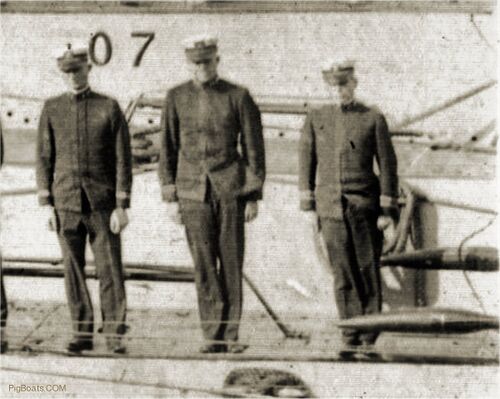
Three officers, a LCDR, a LT, and a LTjg are seen in this close up. Based on rank the Commanding Officer, the LCDR, should be on the right, the XO (LT) in the middle, and the 3rd officer on the left. The discovery of who these officers are is still in progress.
Photo in the private collection of Ric Hedman
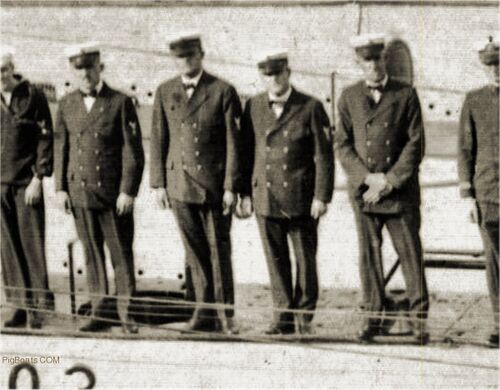
Four Chiefs are seen in this part of the photo. One man, on the right, is a right arm rate, most likely a Gunners Mate (Torpedoman) and other three are left arm rates, possibly Machinist Mates and Electricians. We are unable to see the rates clearly.
Photo in the private collection of Ric Hedman

These men are a mixture of right and left arm rates, none of which can be identified. The second man from the left has crossed signal flags on his right lower arm meaning he was proficient in sending and reading semaphore signals. He is probably a Quartermaster.
Photo in the private collection of Ric Hedman

The man on the extreme left is a 1st Class right arm rate with several specialty patches on his right arm. The lower one looks to be designating him as a Gun Pointer and the one above seems to be a loose figure 8 knot meaning he is an Ex-Apprentice. He may be a Gunners Mate, or probably a Gunners Mate (Torpedoman).
Photo in the private collection of Ric Hedman
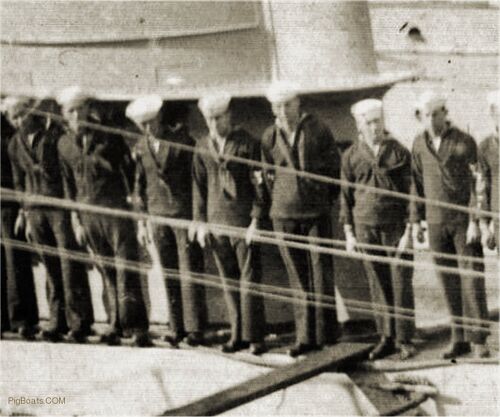
The next group. Not much stands out here that can be commented on. Most of the rate/rank insignia is obscured.
Photo in the private collection of Ric Hedman
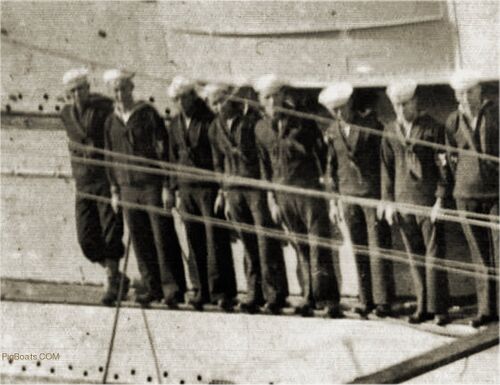
This close up just shows the last three men missing from the last image above. At the far left is a man wearing leggings, who is likely the duty topside watch. There is a man in the background on the O-7 wearing leggings also so this might be a uniform regulation set by the base outlining the duty uniform. (see image below).
Photo in the private collection of Ric Hedman
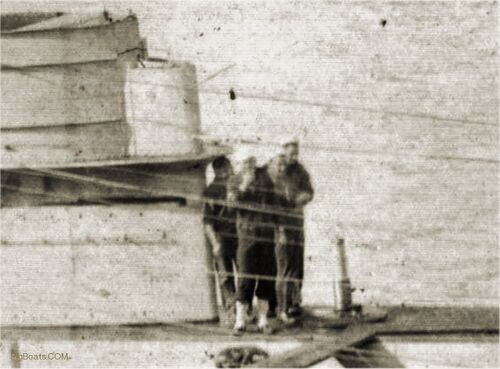
Crew standing on the O-7. The man with the leggings is likely the duty topside watch. The men are standing right next to the upright barrel of the retracted 3"/23 caliber gun.
Photo in the private collection of Ric Hedman
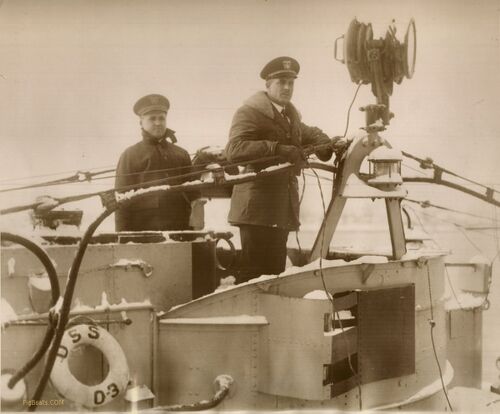
On February 4, 1930, the O-3, enroute from New London, CT. to Portsmouth, NH, ran aground in a heavy snowstorm on a ledge off the Rye coast between Ordiorne Point and the Wallis Sands Coast Guard Station, a few miles south of Portsmouth Harbor. She was aground five hours before the tug M. Mitchell Davis got her off shortly after 11:00 am. There was little damage to the submarine, but she was still towed the rest of the way into the Portsmouth Navy Yard. She going to the shipyard anyway for her annual overhaul after a year of training duty at Submarine Base New London.
The men seen on the bridge are, left to right, Lieutenant (jg) Joseph T. Sheehan from Worcester, Mass and the sub's commanding officer Lieutenant William L. Ware from Swanee, Tenn.
Newspaper wire photo in the private collection of Ric Hedman.
Page created by:
Ric Hedman & David Johnston
1999 - 2023 - PigBoats.COM©
Mountlake Terrace, WA, Norfolk, VA
webmaster at pigboats dot com
